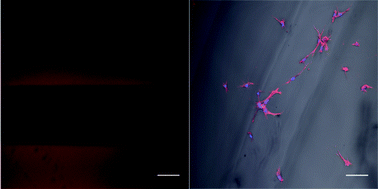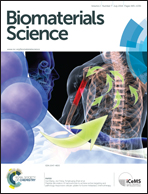A peptide functionalized poly(ethylene glycol) (PEG) hydrogel for investigating the influence of biochemical and biophysical matrix properties on tumor cell migration†
Abstract
To address the challenges associated with defined control over matrix properties in 3D cell culture systems, we employed a peptide functionalized poly(ethylene glycol) (PEG) hydrogel matrix in which mechanical modulus and adhesive properties were tuned. An HT-1080 human fibrosarcoma cell line was chosen as a model for probing matrix influences on tumor cell migration using the PEG hydrogel platform. HT-1080 speed varied with a complex dependence on both matrix modulus and Cys-Arg-Gly-Asp-Ser (CRGDS) adhesion ligand concentration, with regimes in which motility increased, decreased, or was minimally altered being observed. We further investigated cell motility by forming matrix interfaces that mimic aspects of tissue boundaries that might be encountered during invasion by taking advantage of the spatial control of the thiol–ene photochemistry to form patterned regions of low and high cross-linking densities. HT-1080s in 100 Pa regions of patterned PEG hydrogels tended to reverse direction or aggregate at the interface when they encountered a 360 Pa boundary. In contrast, HT-1080s were apparently unimpeded when migrating from the stiff to the soft regions of PEG peptide hydrogels, which may indicate that cells are capable of “reverse durotaxis” within at least some matrix regimes. Taken together, our results identified matrix regimes in which HT-1080 motility was both positively and negatively influenced by cell adhesion or matrix modulus.


 Please wait while we load your content...
Please wait while we load your content...